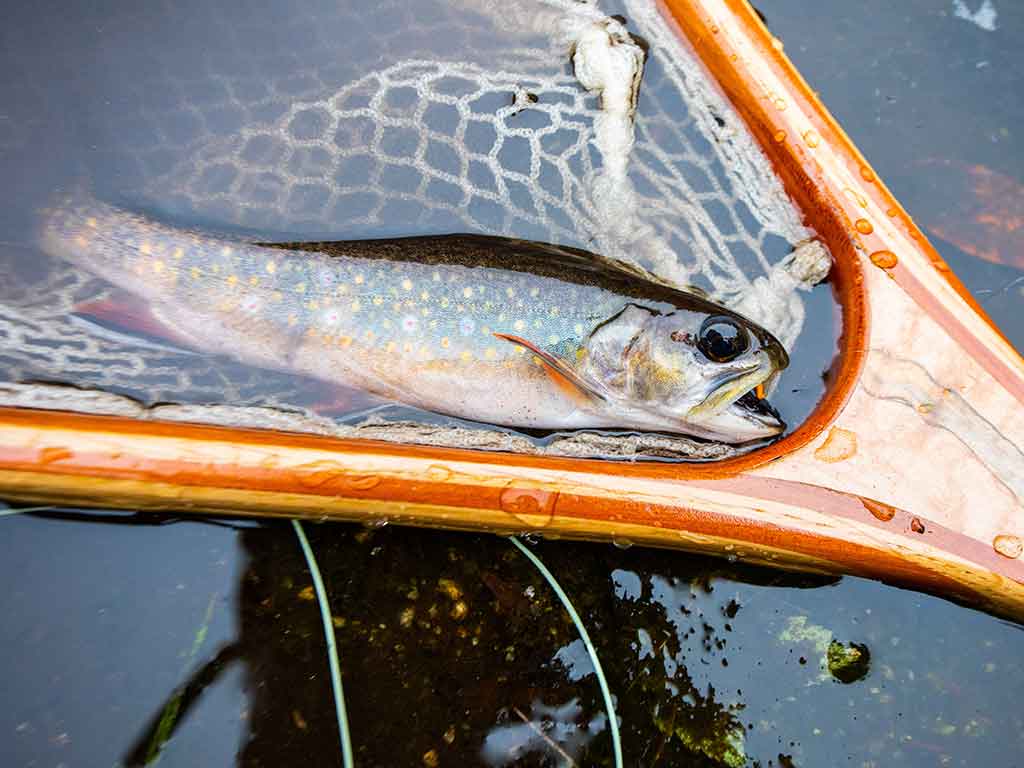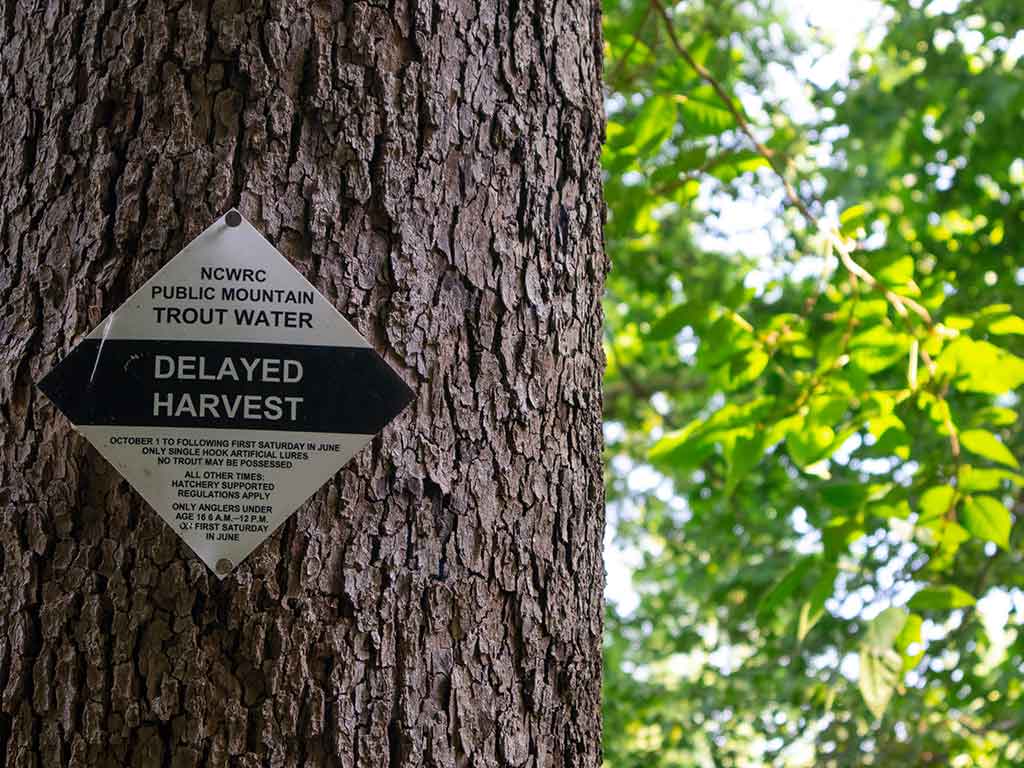Imagine walking along the pristine waters of a mountain stream, searching for the best location to throw out your fly to a hungry Rainbow. While you might find this an everyday scenario in the West, did you know the Southeast US also offers quality Trout angling? If you didn’t, maybe you need to plan a trip to the stunning Appalachian Mountains in western North Carolina. Trout fishing here is considered among the best in the South!

Here, you’ll find over 3,000 miles of rivers, streams, and lakes offering water conditions that Trout thrive in. The state actively encourages Trout fishing with the Mountain Heritage Trout Waters Program. This provides public access to Trout waterways in several cities in western North Carolina.
The North Carolina Wildlife Resource Commission (NCWRC) also operates extensive hatchery and stocking programs. This governing body organizes Trout waters into categories designed to maintain the quality of Trout fishing anglers will experience. The combined approach keeps pace with fishing pressure and provides opportunities for exciting fishing. Add to this the network of inland water guides, and you have the ingredients for an unforgettable Trout fishing adventure! Let’s find out more…
Types of Trout in North Carolina
The “Tar Heel State” has several different Trout species. Each can inhabit a different body of water, with different water temperatures, and will even target different prey. Let’s meet the stars.
Brook Trout

Locals have many names for Brook Trout, including “Brookies,” “Specks,” and “Speckled Trout” – not to be confused with their saltwater equivalents! This is the only Trout species that’s native to North Carolina and is even the state’s freshwater fish. Specks are revered as one of the nation’s most beautiful fish, and their olive green coloring makes a case for it.
These fish prefer specific water parameters and are sensitive to environmental changes. If you’re fishing and catching Brookies, you know the water is clean, cold, and not very polluted.
Brown Trout

Like the explorers that introduced them, Brown Trout came from Europe. Stocking Brownies began sometime between the late 1800s and early 1900s in North Carolina’s waterways. Their golden and olive-brown might not be as colorful as other Trouts, but they can outgrow Brooks and Rainbows, making them a desirable catch.
Unlike the other Trout species in the state, Brownies tend to be more reclusive. They hide in locations that provide cover for ambushing and protection. This includes undercut banks and submerged timber.
Rainbow Trout

Rainbow Trout is another non-native that has learned to thrive in the cold mountain waters of western North Carolina. Imported from the Sierra Nevada range out west in the early 1880s, these fish quickly adapted to the Appalachian conditions.
Rainbow Trout can tolerate warmer waters, which allows them to spread into more waterways than Specks. Add to this their higher tolerance for pollution levels, and you have a Trout that has replaced a dwindling population of natural Brook Trout in many rivers and streams over the decades.
How to Catch North Carolina Trout
One of the reasons native and introduced Trout species thrive in western North Carolina is the cooler water temperatures. Native Brookies stick to cold Appalachian waters, while Browns and Rainbows can tolerate higher water temperatures further downstream.
Today’s Brook Trout population sticks to the clear waters in the state’s mountain streams and rivers, as they’re sensitive to water contaminants common in water at lower elevations. Brown and Rainbow Trout. Meanwhile, are more tolerant of those water pollutants.
Trout are opportunistic feeders, but you will be more successful if you offer flies, baits, or lures they’re used to. Your presentation’s size is also relevant, as an average Brookie might not hit as large of a bait as a big Brown would.
NC Trout Fishing Techniques

If you want to try your skill with live baits, soft cast a worm hooked once or twice at its fattest body section. Don’t ball them up around the hook – that looks unnatural. Use a bobber to help you see strikes when fishing rivers or streams. They’re a good choice after rain or in the spring.
When fishing spinners or spoons, keep in mind your retrieval speed. Retrieve at the slowest possible speed, allowing the blades or spoon to rotate correctly. Cast 45 degrees upstream to pull the lure across a suspected feeding lane.
When you fly fish, approach from downstream (the fish are looking upstream). Cast behind structure when possible. Trout, especially Brookies, will use submerged objects to help break current strength.
When reading the current, remember that deeper waters in the middle and shallow waters near the banks flow slower than surface waters in open areas. Rocks and other structures slow water speed and often hold Trout. Finding slow-moving deep waters behind these structures or drop-offs near riffles mark Trout-holding pools you can explore.
Choosing the Right Bait and Lures for Trout

The key to staying productive is offering items Brook, Brown, and Rainbow Trout enjoy. Natural baits for North Carolina Trout include bait fish, crayfish, grasshoppers, and worms. These are things these fish eat naturally.
If you plan to use lures, spinners and spoons are favored by local anglers. Try copper or gold colors for Browns and silver for Brooks and Rainbows. These colors, flashes, and vibrations should draw in these opportunistic feeders.
Soft-hackle flies are versatile, allowing you to fish from the surface to the bottom of the water. You can tie them to represent any stage of locally-hatching insects or arthropods.
Utilizing Your Gear

When gearing up for Trout in North Carolina, start with graphite fishing poles in the 6–8′ range. Go longer on those barren banks on high mountain streams and shorten the rod length as you fish water with lots of vegetation along the river’s edge. If you want a fun fight, stick with light or medium rods – leave the heavy gear at home.
If you’re fly fishing in North Carolina, select a 9′, 5–6 wt rod. This will give you plenty of control and that line weight range is sufficient for new and experienced casters. Your leaders should be 7–10 feet, and a 5X tippet should serve most fishing situations in these waters.
A short-handled net will be fine for Brookies and other small Trout. Step up to a mid-sized net if you’re fishing where Trout hit the 24-inch range.
North Carolina Trout Fishing Conditions

Paying attention to water temperature is crucial for success. Trout will feed in temperatures from about 45 to 65ºF. They can exist in waters colder and warmer than that, but they feed best within those temperatures. Brookies are usually more active in waters 55ºF and below, while Browns and Rainbows will keep you busy in waters 50ºF and above.
The weather can also improve or hinder your fishing. As water volumes and speed build during the spring runoff, Trout will move deep into the water with less current. Another example is the summer when fish will move deep after 10 a.m., as the sun heats the upper water column. Even fishing during or after rain showers matters – the extra oxygen generated by surface turbulence often triggers more activity.
Local Wisdom and Expert Tips
If you’re new to fly fishing, a golden rule will be to match the hatch. Select flies that imitate the insects on or in the water. No matter what type of fishing you do, always approach the water in a way that won’t spook the fish.
Trout will work smart and not hard, so search for fish that are using structure to reduce the effect of current around them. Dry flies near partially submerged objects can mimic insects that accidentally fall from the exposed surfaces above the waterline.
When to Go Trout Fishing in NC
The best time of year for Trout fishing in the state is April–June and October–December. The spring runoff signals the beginning of fly fishing for many, and spawning Trout head into tributaries and streams. Also, several stocking programs place fish in the water at these times. Spring and fall will provide relatively cool water temperatures as well.
What if you visit during summer? The warmer water means Trout are less active for most of the day. From late June through the end of September, your best bet is to fish before 10 a.m. as the water has had a chance to cool overnight.
Avoid planning Trout excursions in January and February, as the action is slow and the mountain conditions less than ideal.
Another consideration, especially for anyone fly fishing, is the hatches throughout the year. If you’re new to the term, a hatch describes the period when aquatic insects transition from the water to the air. Trout can fixate on these insects during the hatch, ignoring other prey. Knowing when hatches occur can help when planning your trip.
Where to Fish
Trophy-sized Trout are known to inhabit a variety of North Carolina waters. The following locations are just a few you should consider:
Western North Carolina Streams

One of the premiere waterways in the state is the Davidson River, especially if you’re looking for Rainbows or trophy-sized Browns. The 15-mile-long river sits near Brevard, with lots of access off US Route 276. The water upstream from the Bobby N. Setzer State Fish Hatchery is less busy and provides a more secluded fishing experience. Looking for a shot at catching a big Brownie? Fish downstream from the facility’s nutrient-rich discharge.
Another well-known destination is the 48-mile-long Nantahala River, with US Routes 19 and 74 providing access. All three Trout species live here, and extra stocking keeps populations thriving. Waters above Nantahala Lake, below the Whiteoak Creek confluence, and in the Nantahala Gorge will keep you busy. If you’re looking for holdover fish established in the river, try below the dam when it isn’t running.
Delayed-Harvest Waters

Delayed-harvest designations mean the waterway is catch-and-release except for June–September when you can keep the Trout. These waters get stocked in March, April, May, October, and November. During catch-and-keep, there are no bait restrictions, while you’re limited to single-hook flies and lures for the rest of the year.
The upper section of the Tuckasegee River is one of the state’s best delayed-harvest waters. It gets regularly stocked with Brooks, Browns, and Rainbows. Fishing the 5-mile section between Dillsboro and Sylva provides ample fishing, but watch for changing water levels as the dam upstream releases daily.
Wild Trout Waters

Another state waterway classification is “wild Trout” waters – year-round catch-and-keep areas. This designation means you can only use single hook flies or lures, and you may only keep four and they all must be 7 inches or longer.
One example is the Whitewater River off State Highway 281, south of Cashiers and near the South Carolina border. You can use the Overlook Trail to access the latter, with spring and fall being the best times to visit this shallow river. The hike will be worth it, though, as you can wade into healthy populations of Browns and Rainbows here.
North Carolina Trout Fishing Regulations

Before you come Trout fishing in North Carolina, there’s just a bit of housekeeping in order. First, you need to make sure everyone aged 16 or older has their NC inland fishing license. Like most states, the North Carolina Wildlife Resource Commission offers short-term, annual, and combination licenses.
North Carolina also enforces general mountain Trout regulations based on waterway designations, like the Delayed Harvest and Wild Trout Waters described previously.
Hatchery-supported Trout Waters allow a possession of seven Trout with no size or bait restrictions. Wild Trout Natural Bait Waters function like Natural Bait Waters without the artificial fly/lure restriction.
“Catch-and-Release” and “Artificial Fly and Lure” waters are open year-round and require single-hook flies and lures. Special Regulation Trout Waters can limit you to three or fewer fish of 14 inches or less, depending on the location. Undesignated Trout waters have a limit of seven fish.
NC Trout Fishing: A Southeastern Adventure Awaits!
Anyone who’s spent time in western North Carolina can tell you how fun Trout fishing here can be. The region is a gem for anyone looking for Brook, Brown, and Rainbow Trout fishing on par with states out West. The number of guides and facilities dedicated to Trout fishing attest to this.

Residents and government agencies have invested time and money in providing quality access, clean waters, and abundant fish for your pleasure. To fully enjoy the bounty of their labor, follow the rules for the designated areas you fish. These regulations promote and maintain a sizeable fish population in a region not often associated with Trout fishing. Maintaining those populations means we’ll all enjoy Trout fishing in North Carolina for the foreseeable future. But it’s time for you to get out there and enjoy it… now!
Have you ever been Trout fishing in North Carolina? What’s your favorite spot? Any tips and tricks to share? We’d love to hear from you in the comments below!

Jon Stewart has been an avid fisherman for the last 27 years. Originally from Manhattan, Kansas, he currently resides in Texas where he spends every chance he has fishing for Largemouth Bass. He also combines his passion for fishing with his passion for writing, which can be found on FishTechOutdoors where he provides tips and educational guidance on all aspects of Bass fishing.
